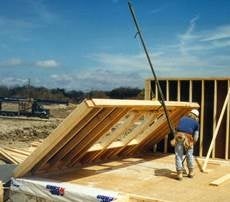The problem
- Walls are constructed on the ground in a horizontal position. After the wall is built, a framing crew lifts the wall to an upright position.
- Workers are exposed to extremely high forces when manually erecting interior and exterior walls of a home. These high forces may put workers at risk of back and shoulder injuries.
- The risk of injury from lifting depends on the weight and size of the load, the number of loads lifted, and the number of workers assisting with the lift.
- Further risk may occur when lifting heavy walls with too few workers or in poor weather conditions (ice, rain, wind).

Manual wall lifting
One solution
- The wall lifter allows newly constructed, low-rise residential wall frames to be lifted with one to two workers.
- The wall lifter is hydraulic, reducing the physical demand required for this task.

Lifting wall with a hydraulic lifter
How it works
- The frame wall lifter hinge plate is secured to the subflooring with nails and the wall metal plate interface is connected to the top of the frame wall.
- One type of lifter is activated by pushing a lever which is hydraulically powered. Others are mechanically powered.
- Once the wall has been lifted to an upright position, 2x4 studs are nailed into place to temporarily hold the wall until it has been permanently secured.
Benefits
- Frame wall lifters reduce the risk of injury since manual lifting of the constructed wall is largely eliminated.
- Risk of crushing injuries is reduced or eliminated because workers are not directly in contact with the wall when it is being lifted.
- Large walls can be lifted by small crews even when other workers are not available for assistance.
- The frame wall lifter may increase productivity because only one to two workers are required to lift the wall.
For more information
- Products may also be found on the internet using the following search terms: “frame wall lifter.”
- Local contractor tool and equipment suppliers or rental companies may be another source of information on products.
- For general information on this solution, call the Infrastructure Health & Safety Association at 416-674-2726 or 1-800-781-2726.